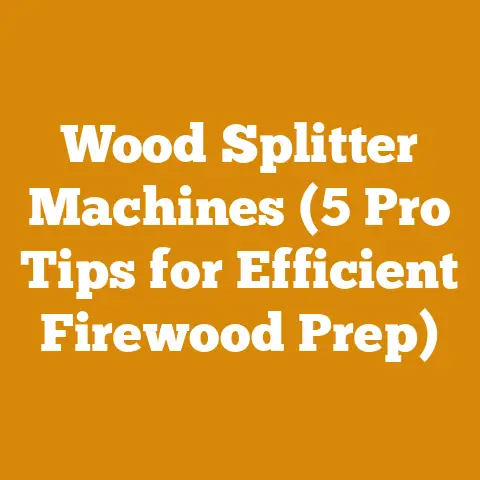Zero Clearance Woodstove Tips (EPA-Certified Fireplaces Guide)
Let’s transform your understanding of wood stoves and fireplaces!
I’m going to guide you through the ins and outs of zero-clearance wood stoves, focusing on EPA-certified models.
This isn’t just about buying a stove; it’s about efficient heating, environmental responsibility, and, most importantly, safety.
Over the years, I’ve helped countless homeowners and even small logging businesses optimize their wood-burning setups.
I’ve seen the good, the bad, and the smoky!
My goal is to equip you with the knowledge to make informed decisions and enjoy the warmth of a wood fire without the headaches.
What is a Zero-Clearance Wood Stove?
A zero-clearance wood stove, often incorporated into a zero-clearance fireplace, is a factory-built appliance designed to be installed directly against combustible walls without the need for extensive fire-resistant construction.
This is a HUGE advantage over traditional masonry fireplaces or freestanding stoves, which require significant clearances.
The term “zero clearance” is a bit of a misnomer; while the stove itself might be able to touch combustible materials, the chimney system still requires specific clearances, usually outlined in the manufacturer’s instructions.
Think of it like this: a freestanding stove requires a protective shield around it to prevent the heat from igniting nearby walls.
A zero-clearance stove has that shielding built-in.
Key Differences:
- Freestanding Stove: Radiates heat in all directions, requires significant clearances.
- Zero-Clearance Stove: Insulated to minimize heat transfer to surrounding walls, can be installed closer to combustible materials.
- Insert: Designed to fit inside an existing masonry fireplace.
While some inserts have zero-clearance capabilities around the firebox, the existing chimney often needs relining.
My Experience: I remember one client who insisted on installing a freestanding stove too close to a wood-paneled wall.
Despite my warnings, he went ahead.
Luckily, he caught the wall smoldering before it turned into a full-blown fire.
That incident reinforced the importance of understanding clearances and following instructions meticulously.
With a ZC stove he would have avoided the issue completely.
Why Choose an EPA-Certified Model?
EPA certification signifies that a wood stove meets stringent emission standards set by the Environmental Protection Agency.
These standards aim to reduce air pollution from wood-burning appliances.
Benefits of EPA Certification:
- Cleaner Burning: Lower particulate matter emissions, resulting in less smoke and pollution.
EPA-certified stoves are significantly cleaner burning than older, non-certified models. - Improved Efficiency: More efficient combustion means you’ll use less wood to generate the same amount of heat.
This saves you money and reduces your environmental impact. - Potential Tax Credits/Rebates: Many jurisdictions offer tax credits or rebates for purchasing EPA-certified wood stoves.
- Healthier Air Quality: Reduced emissions contribute to better indoor and outdoor air quality.
- Compliance with Regulations: In many areas, installing a non-certified wood stove is illegal.
Data: EPA-certified stoves can reduce particulate matter emissions by as much as 70% compared to older, non-certified models.
This translates to significant improvements in air quality, especially in areas where wood burning is common.
Original Insight: Don’t be fooled by the initial cost of an EPA-certified stove.
While they might be more expensive upfront, the long-term savings on firewood and the environmental benefits make them a worthwhile investment.
Step-by-Step Guide to Choosing the Right Zero-Clearance Wood Stove
Determine Your Heating Needs:
- Square Footage: Calculate the square footage of the area you want to heat.
- Climate: Consider your local climate and the severity of winters.
- Insulation: Assess the insulation of your home.
Poor insulation will require a larger stove. - BTU Output: Look for a stove with a BTU (British Thermal Unit) output that matches your heating needs.
A general rule of thumb is 5,000 BTU per 250 square feet in a moderately insulated home. -
Explore Different Models:
-
Steel vs.
Cast Iron: Steel stoves heat up quickly but cool down faster.
Cast iron stoves heat up slower but retain heat longer. - Catalytic vs.
Non-Catalytic: Catalytic stoves use a catalytic combustor to burn off gases and smoke, resulting in cleaner and more efficient burning.
Non-catalytic stoves rely on advanced firebox design and air control. - Hopper Size: Consider the size of the hopper (firebox) and how often you’ll need to reload the stove.
Larger hoppers mean longer burn times. - Aesthetic Appeal: Choose a stove that complements your home’s décor.
Zero-clearance stoves come in a variety of styles and finishes. -
Check EPA Certification and Efficiency Ratings:
-
EPA Website: Visit the EPA website to find a list of certified wood stoves and their emission ratings.
- Efficiency Ratings: Look for stoves with high efficiency ratings.
Higher efficiency means less wood consumption and lower emissions. - Tax Credit Eligibility: Verify that the stove qualifies for any available tax credits or rebates.
-
Consider Chimney Requirements:
-
Chimney Type: Zero-clearance stoves typically require a specific type of insulated chimney pipe.
- Chimney Height: Ensure the chimney is tall enough to create proper draft.
- Clearances: Maintain proper clearances around the chimney pipe.
-
Read Reviews and Get Recommendations:
-
Online Reviews: Read online reviews from other users to get insights into the stove’s performance and reliability.
- Ask for Recommendations: Talk to friends, neighbors, or local stove dealers for recommendations.
-
Visit a Dealer:
-
See the Stove in Person: Visit a local stove dealer to see the stove in person and ask questions.
- Discuss Installation: Discuss installation options with the dealer and get a quote for professional installation.
Tool Specifications: When evaluating stoves, pay attention to the firebox volume (measured in cubic feet), the maximum log length it can accommodate, and the air control system.
A good air control system allows you to regulate the burn rate and efficiency.
Case Study: I once helped a homeowner choose between a catalytic and a non-catalytic stove.
He was concerned about the maintenance requirements of a catalytic combustor.
After discussing his burning habits and wood supply, we determined that a high-efficiency non-catalytic stove was a better fit for his needs.
Step-by-Step Guide to Proper Installation
Safety First: Installation should always be performed by a qualified professional.
Improper installation can lead to fire hazards and carbon monoxide poisoning.
-
Read the Manufacturer’s Instructions:
- Thoroughly review the manufacturer’s installation manual before starting any work.
- Pay close attention to clearance requirements, chimney specifications, and venting instructions.
-
Prepare the Installation Site:
-
Clear the area around the installation site of any combustible materials.
- Ensure the floor is level and can support the weight of the stove.
- Install a non-combustible hearth pad if required by local codes or the manufacturer’s instructions.
-
Install the Chimney System:
-
Use the correct type of insulated chimney pipe recommended by the stove manufacturer.
- Follow the manufacturer’s instructions for assembling and installing the chimney pipe.
- Maintain proper clearances around the chimney pipe.
- Ensure the chimney extends at least 3 feet above the highest point where it passes through the roof and at least 2 feet higher than any structure within 10 feet.
-
Connect the Stove to the Chimney:
-
Carefully connect the stove to the chimney pipe using the appropriate adapters and connectors.
- Ensure all connections are tight and secure.
- Seal any gaps with high-temperature sealant.
-
Install the Facing and Finishing:
-
Install any facing materials around the stove, such as brick, stone, or tile.
- Follow the manufacturer’s instructions for installing facing materials.
- Ensure proper clearances are maintained between the facing materials and combustible walls.
-
Final Inspection:
-
Have a qualified professional inspect the installation to ensure it meets all safety codes and manufacturer’s requirements.
- Obtain any necessary permits from your local building department.
Measurements: Precise measurements are crucial during installation.
Use a laser level to ensure the chimney is plumb.
Double-check all clearances with a measuring tape.
A small error can have significant consequences.
Original Insight: Many homeowners underestimate the importance of a proper chimney system.
The chimney is just as important as the stove itself.
A poorly installed or inadequate chimney can lead to poor draft, smoke backdraft, and even chimney fires.
Step-by-Step Guide to Efficient and Safe Operation
Use Seasoned Wood:
- Seasoned wood has a moisture content of 20% or less.
Green wood contains a high moisture content and burns inefficiently, producing excessive smoke and creosote. - Season wood for at least six months by splitting it and stacking it in a well-ventilated area.
- Use a moisture meter to check the moisture content of your wood.
-
Properly Load the Stove:
-
Use the top-down burning method for cleaner and more efficient combustion.
Place larger pieces of wood on the bottom, followed by smaller pieces and kindling on top. - Leave space between the logs to allow for proper airflow.
- Don’t overload the stove.
-
Control the Airflow:
-
Use the air controls to regulate the burn rate and efficiency.
- Start with the air controls fully open to establish a good fire.
- Once the fire is burning well, gradually close the air controls to reduce the burn rate and increase efficiency.
- Avoid smoldering fires, as they produce excessive smoke and creosote.
-
Maintain a Hot Fire:
-
A hot fire burns more efficiently and produces less smoke and creosote.
- Add wood frequently to maintain a consistent fire.
-
Regularly Inspect and Clean the Chimney:
-
Inspect the chimney regularly for creosote buildup.
- Clean the chimney at least once a year, or more frequently if necessary.
- Hire a professional chimney sweep to clean the chimney.
-
Install a Carbon Monoxide Detector:
-
Install a carbon monoxide detector near the stove to alert you to the presence of this deadly gas.
- Test the detector regularly to ensure it is working properly.
- Seasoned wood has a moisture content of 20% or less.
Wood Type Selection: Hardwoods like oak, maple, and ash provide more heat and burn longer than softwoods like pine and fir.
However, softwoods are easier to ignite and can be useful for starting fires.
Drying Methods: Proper wood stacking is crucial for effective seasoning.
Stack the wood in a single row with gaps between the logs to allow for airflow.
Cover the top of the stack to protect it from rain and snow, but leave the sides open for ventilation.
Statistics: Burning seasoned wood can increase efficiency by 20-30% compared to burning green wood.
This translates to significant savings on firewood.
Case Study: I once helped a homeowner who was experiencing excessive creosote buildup in their chimney.
After inspecting their wood supply, I discovered that they were burning primarily green wood.
By switching to seasoned wood and implementing proper burning techniques, they were able to significantly reduce creosote buildup.
Step-by-Step Guide to Maintenance and Troubleshooting
Regular Cleaning:
- Clean the glass door regularly with a glass cleaner designed for wood stoves.
- Empty the ash pan regularly to prevent ash buildup.
- Clean the firebox periodically to remove any accumulated debris.
-
Inspect and Replace Gaskets:
-
Inspect the door and glass gaskets regularly for wear and tear.
- Replace worn or damaged gaskets to maintain a tight seal.
-
Check Air Controls:
-
Ensure the air controls are functioning properly and not obstructed.
- Lubricate the air control levers if necessary.
-
Monitor Chimney Draft:
-
Monitor the chimney draft to ensure it is adequate.
- A weak draft can cause smoke backdraft and inefficient burning.
-
Troubleshooting Common Problems:
-
Smoke Backdraft: Check for obstructions in the chimney, such as bird nests or creosote buildup.
Ensure the chimney is tall enough and properly sized for the stove. - Slow Burning: Use seasoned wood, ensure adequate airflow, and avoid overloading the stove.
- Excessive Creosote Buildup: Use seasoned wood, maintain a hot fire, and clean the chimney regularly.
- Poor Heat Output: Ensure the stove is properly sized for the area you are heating, check for air leaks around the door and gaskets, and use high-quality firewood.
Tool Specifications: A good chimney brush is essential for cleaning your chimney.
Choose a brush that is the correct size and shape for your chimney.
Costs: The cost of maintaining a wood stove can vary depending on the frequency of use and the type of stove.
Regular chimney cleaning can cost anywhere from $150 to $300 per year.
Replacing gaskets can cost $20 to $50.
Original Insight: Preventive maintenance is key to extending the life of your wood stove and ensuring safe operation.
A little bit of maintenance can go a long way in preventing costly repairs and potential hazards.
Safety Considerations
- Carbon Monoxide Poisoning: Carbon monoxide is a colorless, odorless gas that can be deadly.
Install a carbon monoxide detector near the stove and test it regularly. - Fire Hazards: Keep combustible materials away from the stove and chimney.
Ensure the stove is properly installed and maintained. - Chimney Fires: Chimney fires can occur when creosote buildup ignites in the chimney.
Clean the chimney regularly to prevent creosote buildup. - Burns: Be careful when handling hot surfaces on the stove.
Use gloves or tongs when adding wood. - Smoke Inhalation: Avoid breathing in smoke from the stove.
Ensure the stove is properly ventilated and the chimney is drafting properly.
Material Specs: When replacing chimney components, use only materials that are specifically designed for wood-burning appliances.
Do not use galvanized steel pipe, as it can release toxic fumes when heated.
Timing Estimates: Chimney cleaning should be performed at least once a year, preferably in the spring after the heating season.
Gasket replacement should be performed as needed, typically every 1-2 years.
Skill Levels Required: While some maintenance tasks can be performed by homeowners, more complex tasks, such as chimney cleaning and stove repairs, should be performed by qualified professionals.
Strategic Advantages of Using a Zero-Clearance Wood Stove
- Space Saving: Zero-clearance stoves can be installed in tighter spaces than traditional stoves, making them ideal for smaller homes or apartments.
- Cost Effective: Wood is a relatively inexpensive fuel source compared to oil, gas, or electricity.
- Environmentally Friendly: Burning wood can be a carbon-neutral heating option if the wood is harvested sustainably.
- Reliable: Wood stoves can provide heat during power outages.
- Aesthetic Appeal: Wood stoves can add a warm and inviting ambiance to your home.
Practical Next Steps
- Assess Your Heating Needs: Determine the square footage of the area you want to heat and the BTU output required.
- Research Different Models: Explore different zero-clearance wood stove models and compare their features and specifications.
- Visit a Local Dealer: Visit a local stove dealer to see the stoves in person and ask questions.
- Get a Professional Installation Quote: Obtain a quote for professional installation from a qualified installer.
- Purchase Seasoned Wood: Stock up on seasoned wood for the upcoming heating season.
- Schedule a Chimney Inspection: Schedule a chimney inspection to ensure your chimney is in good condition.
- Install a Carbon Monoxide Detector: Install a carbon monoxide detector near the stove.
- Read the Manufacturer’s Instructions: Thoroughly review the manufacturer’s instructions before operating the stove.
By following these steps, you can enjoy the warmth and comfort of a zero-clearance wood stove while ensuring safety and efficiency.
Remember, responsible wood burning is not only good for your wallet but also for the environment.
Don’t hesitate to reach out to professionals for assistance with installation, maintenance, or troubleshooting.
Happy heating!






